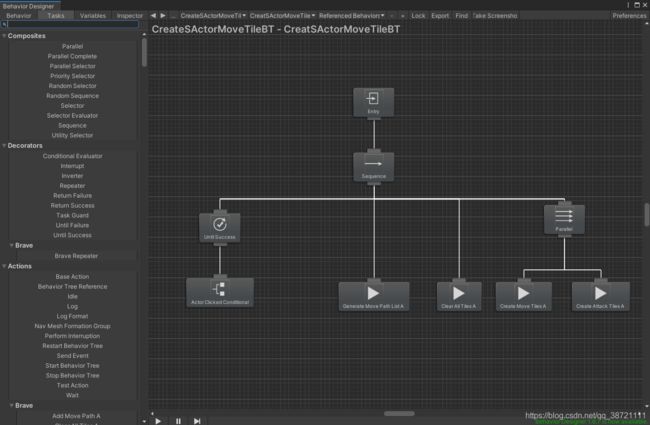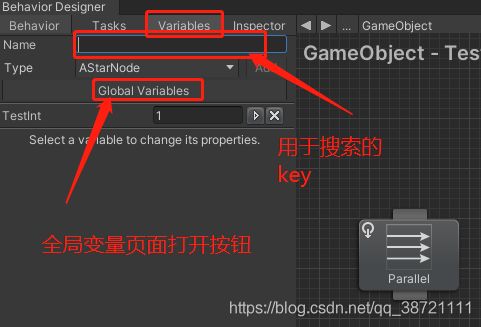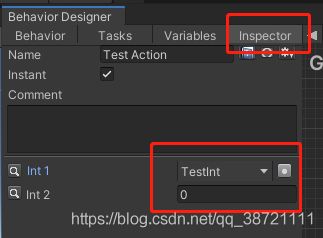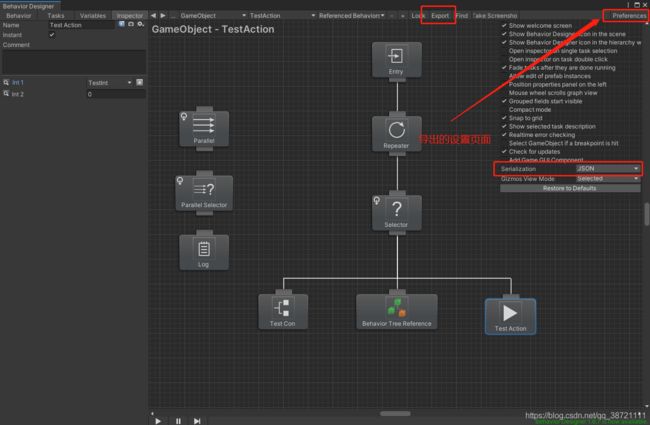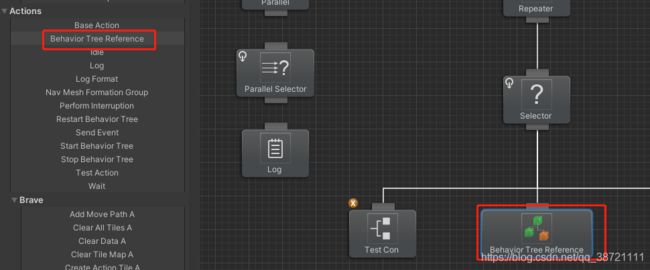Unity中BehaviorTree插件
在Unity3D中,Behabior Designer应该是实现AI最好的工具之一了,Behavior Designer这个插件支持可视化编辑、支持可视化调试。
提供一个Behabior Designer下载链接:https://pan.baidu.com/s/1cpNhLuPhDjrBri4x3mkjaA 密码:gjb5
行为树示例图:
如上图所示,行为树的执行顺序是从左到右,并且是深度优先。
Bahavior行为树节点介绍:
一、Composites组合节点
组合节点必须有子任务,它是由子任务组成的。它包含三个经典的组合节点:
1、Sequence : 从左到右每帧执行一个子节点,当有子节点返回失败时,Sequence就返回失败(不在执行后面的子节点),如果全部返回成功,Sequence才会返回成功
2、Selector : 和Sequence正好相反,从左到右每帧执行一个子节点,当有子节点返回成功时,Selector就返回成功(不在执行后面的子节点),如果全部返回失败,Selector才会返回失败。
3、Parallel : 一帧将全部子节点执行一遍。无论该节点返回成功还是失败,都不影响其余节点的执行。只不过Parallel要根据每个子节点的返回状态决定自己的返回状态。
4、Parallel Selector :一帧将全部子节点执行一遍。全部返回true才返回true。一个返回false则返回false。
5、Parallel Sequence : 一帧将全部子节点执行一遍。全部返回false才返回false。一个返回true则返回true。
二、Decorator装饰节点
该节点只包含一个子节点,并未该子节点添加一些特殊的功能,如让子节点循环操作或者让子task一直运行直到其返回某个运行状态值,或者将task的返回值取反等等
三、Action行为节点
行为节点是真正做事的节点,其为叶节点。一般来说行为节点是有我们自己编写的节点。
四、Conditinals 条件节点
用于判断某条件是否成立。目前看来,是Behavior Designer为了贯彻职责单一的原则,将判断专门作为一个节点独立处理,比如判断某目标是否在视野内,其实在攻击的Action里面也可以写,但是这样Action就不单一了,不利于视野判断处理的复用。
行为树中的全局变量和局部变量
设置与得到的方法:
int testInt;
private void Awake()
{
GetComponent().GetVariable("TestInt");
GetComponent().SetVariable("TestInt" , (SharedInt)testInt);
GlobalVariables.Instance.SetVariable("TestGlobalInt",(SharedInt)testInt);
GlobalVariables.Instance.GetVariable("TestGlobalInt");
}
行为树中的变量类型
public SharedInt int1;
public int int2;显示如下:
share和普通类型的区别:share可以访问行为树中的局部变量,也方便为外部修改,普通类型只能在特定树特定节点去修改,share在使用的时候必须.Value去访问它的值,普通类型就不需要
自定义数据类型
定义
using BehaviorDesigner.Runtime;
[System.Serializable]
public class SharedNew_Type : SharedVariable
{
public static implicit operator SharedNew_Type(New_Type value)
{
return new SharedNew_Type { Value = value };
}
}
[System.Serializable]
public class New_Type
{
public int @int = 1;
public bool @bool = false;
}
调用
using System.Collections;
using System.Collections.Generic;
using UnityEngine;
using BehaviorDesigner.Runtime.Tasks;
using BehaviorDesigner.Runtime;
public class TaskB : Action
{
public SharedNew_Type s_NewType;
public float SomeFloat = 1;
public override void OnAwake()
{
base.OnAwake();
s_NewType.Value = new New_Type();
Debug.Log(s_NewType.Value.@int);
Debug.Log(s_NewType.Value.@bool);
}
}
树的启用和禁用
tree.EnableBehavior(); //启用
tree.DisableBehavior(); //禁用
行为树导入导出
在活动节点可以添加外部行为树
参考:https://blog.csdn.net/qq_38358224/article/details/111766752?utm_medium=distribute.pc_relevant.none-task-blog-baidujs_title-0&spm=1001.2101.3001.4242
参考二:https://blog.csdn.net/qq826364410/article/details/80025362
